Vincenzo Galdi
Rapid diagnostics of reconfigurable intelligent surfaces using space-time-coding modulation
May 06, 2025Abstract:Reconfigurable intelligent surfaces (RISs) have emerged as a key technology for shaping smart wireless environments in next-generation wireless communication systems. To support the large-scale deployment of RISs, a reliable and efficient diagnostic method is essential to ensure optimal performance. In this work, a robust and efficient approach for RIS diagnostics is proposed using a space-time coding strategy with orthogonal codes. The method encodes the reflected signals from individual RIS elements into distinct code channels, enabling the recovery of channel power at the receiving terminals for fault identification. Theoretical analysis shows that the normally functioning elements generate high power in their respective code channels, whereas the faulty elements exhibit significantly lower power. This distinction enables rapid and accurate diagnostics of elements' operational states through simple signal processing techniques. Simulation results validate the effectiveness of the proposed method, even under high fault ratios and varying reception angles. Proof-of-principle experiments on two RIS prototypes are conducted, implementing two coding strategies: direct and segmented. Experimental results in a realistic scenario confirm the reliability of the diagnostic method, demonstrating its potential for large-scale RIS deployment in future wireless communication systems and radar applications.
Design of stacked intelligent metasurfaces with reconfigurable amplitude and phase for multiuser downlink beamforming
Aug 29, 2024Abstract:A novel technology based on stacked intelligent metasurfaces (SIM) has recently emerged. This platform involves cascading multiple metasurfaces, each acting as a digitally programmable physical layer within a diffractive neural network. SIM enable the implementation of signal-processing transformations directly in the electromagnetic wave domain, eliminating the need for expensive, high-precision, and power-intensive digital platforms. However, existing studies employing SIM in wireless communication applications rely solely on nearly passive structures that control only the phase of the meta-atoms in each layer. In this study, we propose a SIM-aided downlink multiuser transmission scheme, where the SIM at the base station (BS) end is designed by combining nearly passive layers with phase-only reconfiguration capabilities and active layers integrated with amplifier chips to enable amplitude control. Our optimal design aims at maximizing the sum rate for the best group of users by jointly optimizing the transmit power allocation at the BS and the wave-based beamforming at the SIM. In addition to the standard sum-power constraint at the BS, our optimization framework includes two additional constraints: (i) a per-stream power preserving constraint to prevent propagation losses across the SIM, and (ii) an amplitude constraint to account for power limitations for each active layer. To further reduce the complexity of the optimal beamforming solution, we explore a simple yet suboptimal zero-forcing (ZF) beamforming design, where the wavebased transformation implemented by the SIM is selected to eliminate interference among user streams. Finally, extensive Monte Carlo simulations demonstrate that incorporating both nearly passive and active layers within the SIM significantly enhances capacity compared to previously reported phase-only coding SIM.
Integrating sensing and communications: Simultaneously transmitting and reflecting digital coding metasurfaces
Jun 16, 2024Abstract:Wireless networks are undergoing a transformative shift, driven by the crucial factors of cost effectiveness and sustainability. Digital coding metasurfaces (DCMs) might play a key role in realizing cost-effective digital modulators by harnessing energy embedded in electromagnetic waves traversing through the air. Integrated sensing and communication (ISAC) optimize power and spectral resources by combining sensing and communication functionalities on a shared hardware platform. This article presents a tutorial-style overview of the applications and advantages of DCMs in ISAC-based networks. Emphasis is placed on the dual-functionality of ISAC, necessitating the design of DCMs with simultaneously transmitting and reflecting (STAR) capabilities for comprehensive space control. Additionally, the article explores key signal processing challenges and outlines future research directions stemming from the convergence of ISAC and emerging STAR-DCM technologies.
Space-time reconfigurable intelligent surfaces for downlink multiuser transmissions
Apr 24, 2023Abstract:Amplitude, phase, frequency, and polarization states of electromagnetic (EM) waves can be dynamically manipulated by means of artificially engineered planar materials, composed of sub-wavelength meta-atoms, which are typically referred to as metasurfaces. Until now, researchers in wireless communications have mainly focused their attention on space-domain designs of reconfigurable intelligent surfaces (RISs), where the main concern is to engineer the spatial-phase gradient across the RIS to decouple incidence and reflected/refracted directions. However, such designs do not exploit the temporal dimension. Indeed, additional degrees of freedom for controlling EM waves can be gained by applying a time modulation to the reflection response of the metasurface, thereby attaining the so-called space-time RISs. We develop a general framework where a downlink multiuser transmission over single-input single-output slow fading channels is assisted by a digitally controlled space-time RIS. The conclusions of our analysis in terms of system design guidelines are as follows: (i) if the network utility function is the sum-rate time-averaged network capacity, without any constraint on fair resource allocation, and full CSIT is available, then a temporal modulation of the electronic properties of the RIS is unnecessary; (ii) if partial CSIT is assumed only, a random modulation in both time and space of the reflection coefficients of the RIS meta-atoms allows to achieve a suitable balance between sum-rate time-averaged capacity and user fairness, especially for a sufficiently large number of users; (iii) regardless of the available amount of CSIT, the design of temporal variations across the RIS is instrumental for developing scheduling algorithms aimed at maximizing the network capacity subject to some fairness constraints.
Modeling the Mutual Coupling of Reconfigurable Metaurfaces
Oct 16, 2022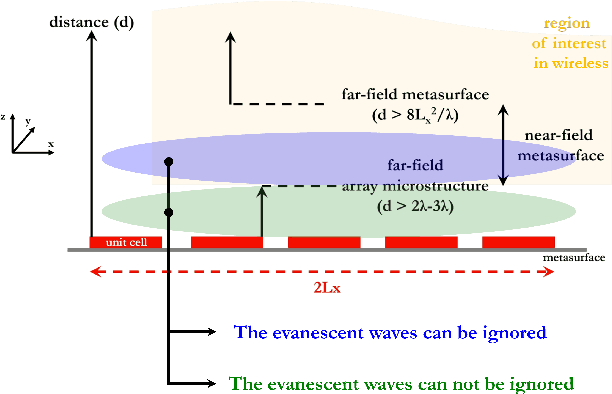

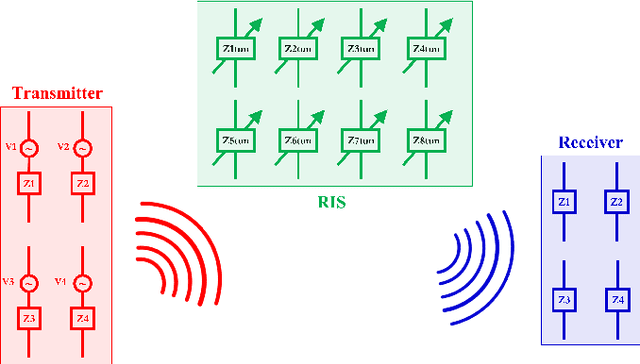
Abstract:In [1], the authors have recently introduced a circuits-based approach for modeling the mutual coupling of reconfigurable surfaces, which comprise sub-wavelength spaced passive scattering elements coupled with electronic circuits for enabling the reconfiguration of the surface. The approach is based on a finite-length discrete dipole representation of a reconfigurable surface, and on the assumption that the current distribution on each thin wire dipole is a sinusoidal function. Under these assumptions, the voltages at the ports of a multi-antenna receiver can be formulated in terms of the voltage generators at a multi-antenna transmitter through a transfer function matrix that explicitly depends on the mutual coupling and the tuning circuits through the mutual impedances between every pair of thin wire dipoles. In [1], the mutual impedances are formulated in an integral form. In this paper, we show that the mutual impedances can be formulated in a closed-form expression in terms of exponential integral functions.
Digital Reconfigurable Intelligent Surfaces: On the Impact of Realistic Reradiation Models
May 19, 2022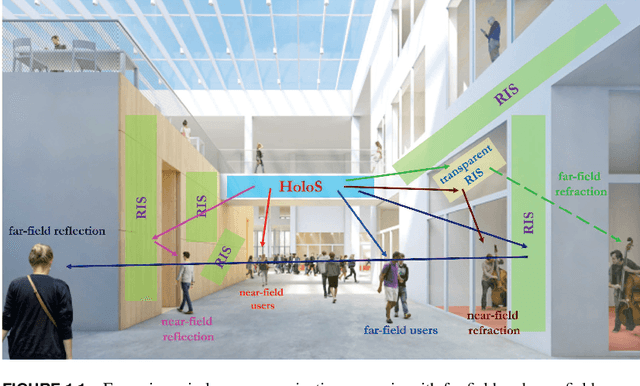
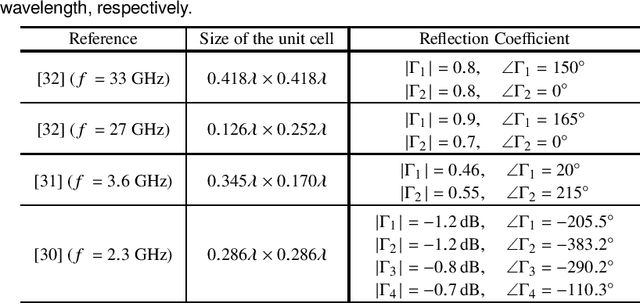
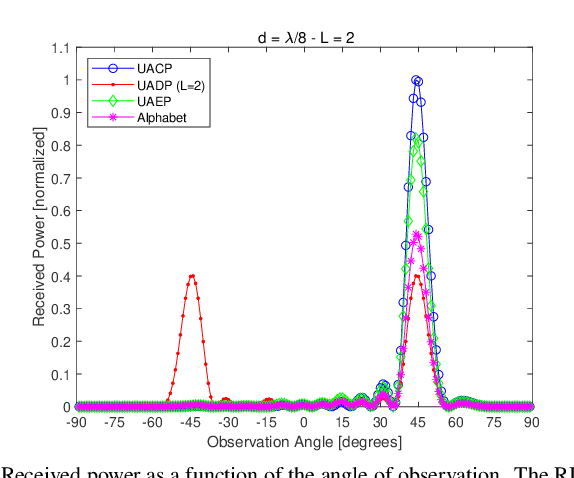
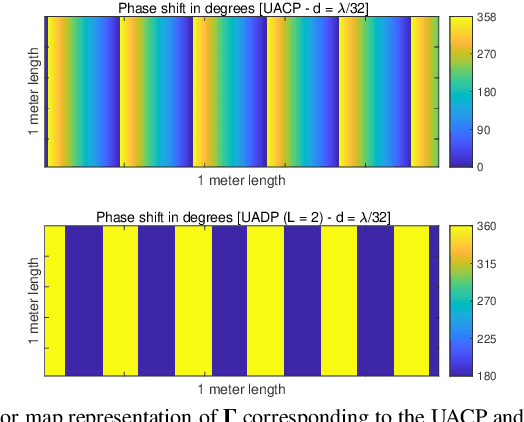
Abstract:Reconfigurable intelligent surface (RIS) is an emerging technology that is under investigation for different applications in wireless communications. RISs are often analyzed and optimized by considering simplified electromagnetic reradiation models. In this chapter, we aim to study the impact of realistic reradiation models for RISs as a function of the sub-wavelength inter-distance between nearby elements of the RIS, the quantization levels of the reflection coefficients, the interplay between the amplitude and phase of the reflection coefficients, and the presence of electromagnetic interference. We consider both case studies in which the users may be located in the far-field and near-field regions of an RIS. Our study shows that, due to design constraints, such as the need of using quantized reflection coefficients or the inherent interplay between the phase and the amplitude of the reflection coefficients, an RIS may reradiate power towards unwanted directions that depend on the intended and interfering electromagnetic waves. Therefore, it is in general important to optimize an RIS by considering the entire reradiation pattern by design to maximize the reradiated power towards the desired directions of reradiation while keeping the power reradiated towards other unwanted directions at a low level. Our study shows that a 2-bit digitally controllable RIS with an almost constant reflection amplitude as a function of the applied phase shift, and whose scattering elements have a size and an inter-distance between (1/8)th and (1/4)th of the signal wavelength may be a good tradeoff between performance, implementation complexity and cost. However, the presented results are preliminary and pave the way for further research into the performance of RISs based on accurate and realistic electromagnetic reradiation models.
 Add to Chrome
Add to Chrome Add to Firefox
Add to Firefox Add to Edge
Add to Edge